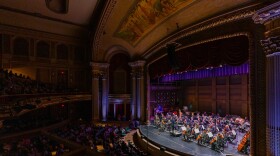You might recognize Tadashi Sato's gigantic circular mosaic at the Hawaiʻi State Capitol's rotunda, the piece that depicts submerged rocks and water reflections.
But there's a painting of his early work at the University of Hawai‘i at Mānoa’s RISE Center as part of a permanent exhibit called “Metcalf Château."
Allison Wong is the curator and says Sato’s art style is easy to spot because of his brush strokes and ethereal compositions.
“You can see his traditional cross-hatching brush strokes that he’s known for,” she said. "But a very contemplative piece. You can finally see a road or an abstract cloud. It’s a wonderful painting.”
Sato was part of a group of seven Asian American artists who were instrumental in Hawai‘i’s art movement. Many of them spent time in New York, Japan and Europe. They brought home abstract expressionism and immersed themselves in the art form — brush stroke by brush stroke.
The original seven artists were Satoru Abe, Bumpei Akaji, Edmund Chung, Tetsuo “Bob” Ochikubo, Jerry Okimoto, James Park and Tadashi Sato.

Abstract Expressionism emerged in the United States, specifically New York, during the 1940s. It was a way for artists to escape the fear and trauma after World War II. The artwork is recognized by expressive brush strokes and paint flicks on a canvas. Each work captures the emotion the artists are feeling at the time.
Walter Dods Jr. was a longtime CEO of First Hawaiian Bank and funded the UH Mānoa RISE Center. He said the Metcalf artists were students at the University of Hawaiʻi when Pearl Harbor was attacked, and faced difficulties due to their ethnicities.
In 1954, the artists held an exhibit in a dilapidated house at 2022 Metcalf St., which was slated for demolition. That earned the group their name — “Metcalf Château.”
It’s also a block away from the exhibit on the same street. Wong said that was intentional to honor the artists.
The artists were only in the house for about six months. But their name gained recognition, catching the attention of the former director of the then-called Honolulu Academy of Arts.
“It became a hit,” Dods said. “It was modernism, island style, created by this original group. They’re the most famous artists that we know of today. Tadashi Sato, Isami Doi, Bumpei Akaji, all 13 of them, have left their mark on our community."
In fact, Akaji’s sculpture is displayed prominently in front of the RISE Center. Akaji was a member of the 442nd Regimental Combat Team during World War II. He was also the first to earn a Master of Fine Arts degree from UH Mānoa in 1952.
Dods has a few of the artists’ artworks in his collection. He said that more than half of the art pieces were donated by him and the artists’ families.
All the art pieces are either in glass containers or plexiglass.
“A lot of the younger artists really admire these artists in terms of this renaissance period in Hawaiʻi,” Wong said.
Wong and Dods said they are still searching for Edmund Chung’s artworks to complete the exhibit in honor of the artists who were instrumental in Hawaiʻi’s art history.






